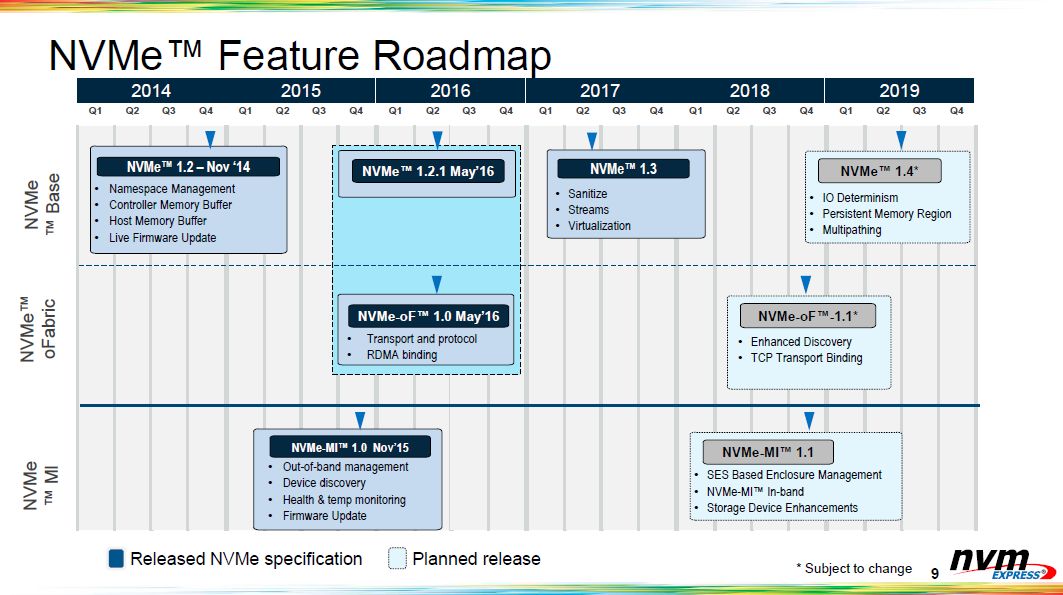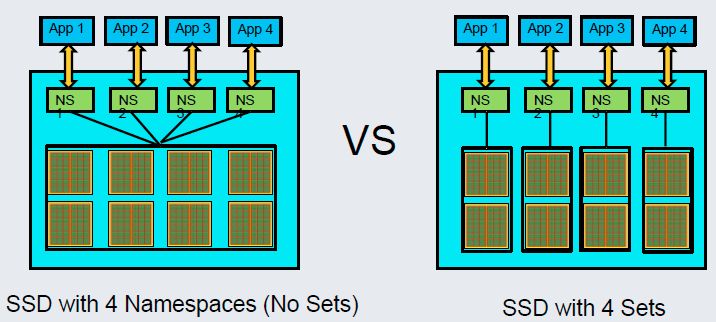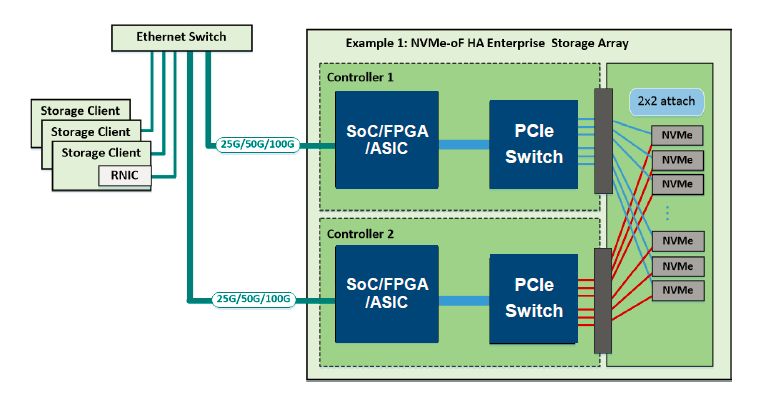FMS2018 has passed, but the popularity of flash memory has not subsided. The NVMe organization introduced topics such as NVMe, NVMe-oF, NVMe-MI, JBOF, and NVMe benchmark testing through 8 speeches at FMS2018. There is a PPT of this speech on its official website (it is said that the video will also be updated). Next, let's look at the focus of the evolution of NVMe in the coming year through the keynote speech of the NVMe organization at FMS2018.

The roadmap of the NVMe protocol family (click to enlarge, the same below)
From the above figure, you can see some of the main features of current NVMe and the focus of the next step. This article talks about the two major updates of NVMe 1.4. The latest version of the NVMe standard on the NVMe official website is 1.3c, which was released on May 24, 2018. In the fourth quarter of this year and 2019, the NVMe1.4 version will be the focus of the NVMe standardization organization. The focus of this update includes IO Determinism, PMR, and multipath access to the shared namespace.
About namespace (namespace)
Namespace is a basic logical space concept in the NVMe protocol. Simply put, the namespace logically divides the user space of NVMe SSD. Each namespace has its own NAND, which can be formatted and encrypted independently. operating.
IO Determinism: NVMe improves QoS like this
The NVMe protocol will define IO Determinism in version 1.4 to achieve refined management and control of SSD physical media resources. Without IO Determinism, multiple apps are carried by one SSD. Although multiple apps access different namespaces, different namespaces share the underlying channel and die.

The change of load access disk before and after IO Determinism application (this picture is also a test plan of the test results in the figure below)
With IO Determinism, the NVMe protocol can divide the physical space of the entire SSD into multiple NVM Sets. Each NVM Set can contain one or more Channels and Dies. The erasing, reading and writing of different NVM Sets are mutually exclusive. Independent, and finally different Sets are used by different apps (as shown on the right in the figure above). In this way, applications will not interfere with each other, and performance and latency can be better guaranteed. Facebook released detailed test results on NVMe SSD's implementation of IO Determinism on FMS2018, as shown in the figure below:

Facebook's test results after the application of IO Determinism
From the above picture of Facebook’s test results on IO Determinism, it can be seen that the read delay QoS has been improved by 8 times after the application of IO Determinism (for specific test instructions, please refer to the Facebook speech PPT on FMS2018 in related reading). In addition, the capacity of a single NVMe SSD is increasing (Memblaze's PBlaze5 910/916 can achieve 15.36TB). IO Determinism divides a large disk into multiple “small disks†for use by multiple upper-level applications, which improves resource utilization. rate.
NVMe multipath access to shared namespace
NVMe multipath access to the shared namespace means that single or multiple hosts can access the same namespace through different NVMe Controllers. The figure below is a basic principle.

This feature will affect the design of storage systems such as flash memory arrays in the future. Currently, high-availability NVMe storage systems mostly use dual-port NVMe SSDs, and the following schemes are used to implement them:

With the multi-path access feature after NVMe1.4, a highly available storage system can combine with the dual port of NVMe SSD to achieve a highly available solution like the one shown in the figure below. Each Contorller can see two paths of one port of NVMe SSD, which requires NVMe SSD to support multipath function.

This is similar to the concept of achieving a high-availability system in the SAS era, except that the performance from the Switch to the disk has been qualitatively improved. JBOD has also been upgraded to JBOF/FBOF. Business continuity and data integrity are important requirements of enterprise customers for storage systems. To create a high-availability solution, Memblaze has accumulated a lot in the research and development of dual ports. For relevant discussions and technical interpretations, please see the article on dual ports at the end of the article.
Finally, the NVMe protocol has two important branches, NVMe-MI and NVMe-oF, which respectively define NVMe SSD management commands and network-level specifications. In the future, these two branches will also evolve. NVMe-MI will allow applications to send NVMe-MI Send and NVMe-MI Receive to the NVMe subsystem (usually NVMe SSD or a group of multiple NVMe SSDs) through In-Band. Two new commands to get the basic information of the subsystem. This information was mostly obtained by the BMC system before. This new feature improves the application's ability to obtain the underlying SSD status information, and can more efficiently perceive the health status of the NVMe subsystem.
NVMe-oF will also start to support NVMe Over TCP. This part of the content will be explained in detail in subsequent articles.
Industrial and Medical Display
There are many kinds of LCD classification standards, which can be divided into passive matrix and active matrix according to the driving mode
Passive matrix: Passive matrix LCD can be divided into TN-LCD(TwistedNematic LCD), STN-LCD(SuperTN-LCD) and DSTN-LCD(Doublelayer STN-LCD).
Active matrix: Active matrix LCD, also known as TFT-LCD, is widely used at present. Tft-lcd is short for thin-filmliquid-Crystal Display
The TFT-thin Film Transistor
Liquid Crystal Display
Short for TFT-LCD Liquid-CrystalDisplay
Tft-lcd has been widely used in various display equipment due to its advantages of small size, light weight, low radiation, low power consumption and full color.
Functions of TFT-LCD structure
(1) Backlight plate module: provide the source of light;
(2) Upper and lower polarizing plates, TFT Glass Substrate, liquid crystal: forming polarized light, controlling the passage of light;
(3) Color filters: Provide TFT LCD red, green and blue (three primary colors of light) sources;
(4) ITO transparent conductive layer: provide transparent conductive path;
(5) Photo Spacer: Provide a fixed height for color filters and TFT Glass Substrate. As a space for liquid crystal infusion, and as a support for the upper and lower Glass layers.
Medical Display,Medical Lcd Monitor,Medical Monitor,Medical Grade Monito
TONYA DISPLAY LIMITED , https://www.tydisplay.com
